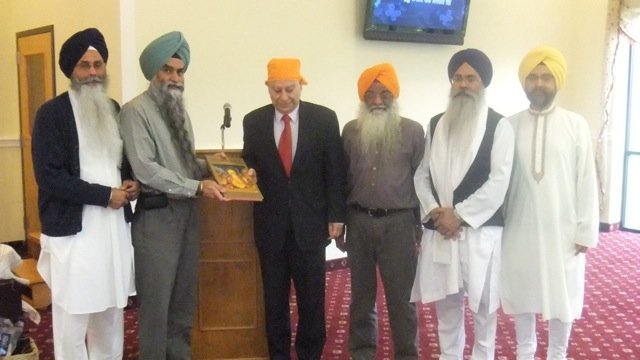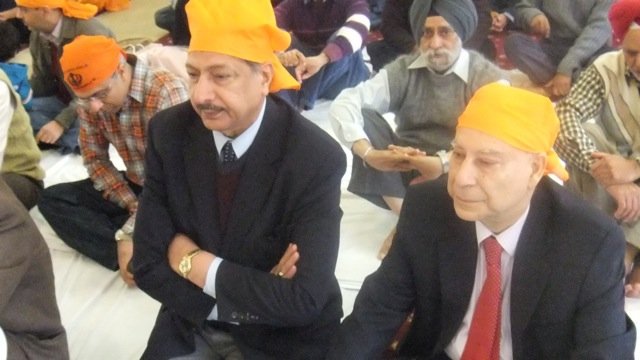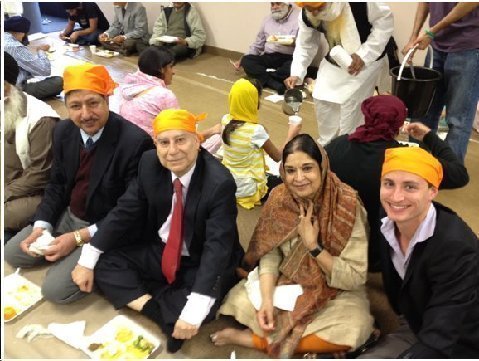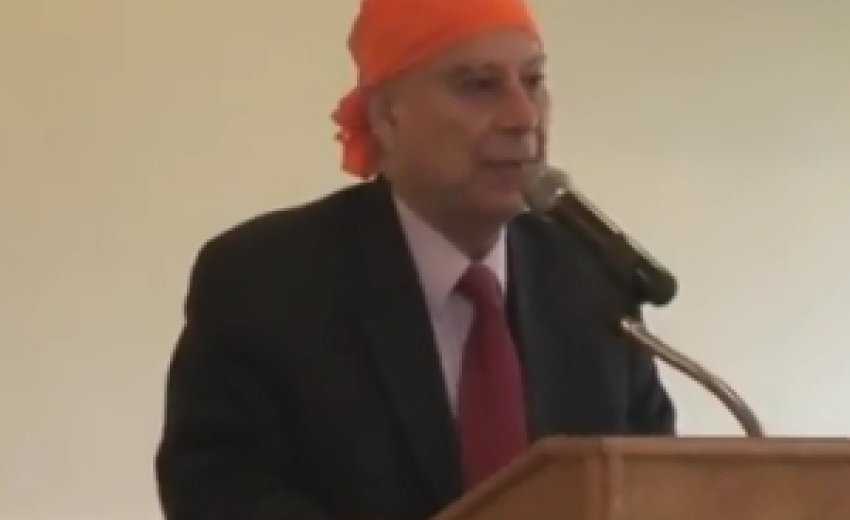On November 22, Ambassador Akbar Ahmed, Pakistan’s former high commissioner to United Kingdom and Ireland called Guru Nanak ‘a prince of Interfaith Dialogue’. Speaking at the birthday celebrations of Guru Nanak, the Founder of Sikhism at Guru Gobind Singh Foundation (GGSF) in Rockville, Maryland, a suburb of Washington, DC, Mr. Ahmed that “we are living in a world of change and a world of challenge and after 9/11 these challenges are accentuated and Guru Nanak’s life and his teachings and instructions provide us the answers.”
Ambassador Ahmed, a scholar of Islamic studies at American University in Washington DC and at the US Naval Academy in Annapolis, is a Senior Fellow at the Brookings Institution, Washington’s leading think tank. He is also a writer of many books. He has taught at Princeton, Harvard, and Cambridge Universities. Regularly interviewed by CNN, NPR, BBC, Fox, he has appeared several times on Oprah, and has also been a guest of The Daily Show and Nickelodeon. Ahmed was the Pakistan High Commissioner (Ambassador) to the UK and Ireland.
During his first ever visit to a Sikh congregation, He stated, “If we are looking for a model, Guru Nanak gives us the best model in the 21st century. I feel a great sense of pride in figures like Guru Nanak from South Asia who brings us together and tell us to hold on to the concept of unity of God.”
He added, “Guru Nanak gave us as a framework to be able to meditate on the beauty of God and beauty of unity; to be householders and yet think of Divinity; and finally to live as a community and to share our wealth. These are wonderful principles for any society. "
 |
| Ambassador Ahmed receiving memento from officials of Guru Gobind Singh Foundation. From left to right: Ranjit Singh Kaler, Sarabjit Singh Sidhu, Ambassador Ahmed, Chattar Singh Saini, Bhai Gurdarshan Singh and Dr. Rajwant Singh |
He quoted one of his favorite sayings of Guru Nanak ‘When I give myself to thee O, Lord, the whole world is mine.’ and said, “Everyone can related to it and I, as a Muslim, can also relate to it.”
He added, “Guru Nanak played an important role in the South Asian region. Through Guru Nanak you have a great intersection of history between two great religions, Hinduism and Islam and now the third religion Sikhism. So you have all the great currents of history meeting in Guru Nanak.”
Ahmed shared his personal pain of partition when in 1947 India and Pakistan separated. He said it felt like “a knife had gone through the heart of all of us… and separated us, the brothers and sisters.” He urged that the healing process must begin by saying “Here we have a opportunity in United States to begin the process of healing and that is the ultimate message of Guru Nanak in the 21st Century. His message of love and compassion constantly inspires us in our daily lives.”
Ahmed narrated the message of Guru Nanak during his visit to Mecca, Islam’s holiest shrine `’that God is present everywhere and it struck me even as a young boy growing up in Abbotabad that there is so much depth and sense of compassion in Guru Nanak’s observation.”
 |
| Nisar Chowdhury and Ambassador Ahmed with Sikhs at Guru Gobind Singh Foundation |
He also regretted that a shrine built in memory of Guru Nanak’s visit to Baghdad was damaged recently. He said, “Guru Nanak’s shrine is a testament and we ought to preserve history and in turn we preserve ourselves. It provides us the dignity and identity with the message of Guru Nanak that comes to us through generations.
Ahmed reminded to a large audience about the close connections between the two communities. He said, “We know of close connections with Sikhism and Islam. We know that Mian Mir, a great Sufi saint from Lahore laid the foundation of the Golden Temple and Mughal Emperor Akbar gave a golden gift to the Guru Granth Sahib (Sikh Scriptures). We also know that when Dara Shikoh, a Mughal prince fell ill and who was very close to the Sikhs, Sikh Guru prayed for him. We also know the problems with Mughal emperor Aurengzeb but we must remember that it was not a clash between religions. Aurengzeb in fact imprisoned his own father.”
Dr. Rajwant Singh, Secretary of GGSF, welcomed Ambassador to the Sikh congregation and said, “ We are touched by Ambassador Ahmed’s comments. They are indeed full of passion and deep appreciation for Guru Nanak. We are also proud of Ambassador’s contributions in the field of interfaith dialogue and his desire to bring people of Indian subcontinent together. All religions in the Indian subcontinent must initiate a lead towards civil dialogue rather than always be led by politicians or geopolitical events. Ahmed's presence today was befitting while we are celebrating Great Guru’s life.”
 |
| From Left: Nisar Chowdhury, Ambassador Ahmed, Manjula Kumar of Smithsonian Institution and Dylan Kaplan, Senator of the Student Body of the American University partaking Sikh langar during the celebrations |
Sarabjit Singh Sidhu, Chairman of GGSF, presented a book on Sikhsim and Guru Nanak on behalf of the Sikh congregation and said, “We pray that Ambassador Ahmed continues to work towards bringing harmony in a broken world. The world needs persons of faith like him who can create a loving world in line with the vision of Guru Nanak.”
Later Manjula Kumar, a prominent Indian and a director at the Smithsonian institute, said, “Ahmed was creating history... I have never had such a wonderful experience at any Gurdwara.”
Dr. Nisar Chaudhury, the President of the Pakistan American league , who advocates people to people contact among Indians and Pakistanis to foster harmony in the subcontinent and has organized trips of Pakistani physicians to visit India recently, was also visiting his first Gurdwara with the Ambassador and was thrilled. Sardar Harcharan Singh Brar who is head of the Mian Mir foundation in Amritsar and his organization is working to bring together relatives separated during the tragedy of the partition and has brought together 600 people together such families also spoke.
Ambassador Ahmed had received a Bridge Builder's Award from the Interfaith Conference of Metropolitan Washington.
Ambassador Akbar Ahmed's Speech at GGSF:
---------------------------------
Related Story:Seeking Sikh-Muslim peace
By Dylan Kaplan
Seeking sikh-muslim peace
The large Sikh men with long white beards pounded the drums. Sikh men with red, blue, and orange colored turbans sat cross-legged in all corners of the sanctuary. Women dressed in bold blue, green, and purple Punjabi suits sat consumed in prayer. As I sat on the red carpet among the 300-400 guests in the audience with my hair covered in an orange cloth and my feet crossed I could not help but realize the significance of this moment as the Sikh prayers seemed to float towards heaven and consumed me. I had to constantly remind myself that I was not in a Sikh Gurdwara, the temple of worship for Sikhs, in a village in the Indian Punjab but in Rockville, Maryland.
Last Sunday, November 13th, I had the privilege of attending the most important Sikh holiday, honoring Guru Nanak, the revered founder of Sikhism. My mentor, Ambassador Akbar Ahmed, whom the BBC calls “the world’s leading authority on contemporary Islam” was invited by the Sikh community to give the keynote address. This was the first time that a Muslim had ever been invited to speak at this very large Sikh temple. Ambassador Ahmed spoke about religious pluralism and tolerance and the need for Muslims and Sikhs to live at peace. The ambassador explained that through Guru Nanak’s life we “learn how he promoted the dialogue between the two great religions of India; Hinduism and Islam which added to the beauty and birth of Sikhism.” Ahmed quoted one of his favorite sayings of Guru Nanak: “When I give myself to thee O Lord, the whole world is mine.” He also spoke of the great Sufi Islamic saint Mian Mir, who, in an act of religious pluralism, was invited by Guru Arjan to lay the foundation stone at the Golden Temple, the Mecca of Sikhism.
Ahmed reminded us about the pain of partition when in 1947 India and Pakistan separated. He urged that the healing process begin. When Ambassador Ahmed finished, Dr. Rajwant Singh, chairman of the Sikh Council on Religion and Education, said “my heart was pounding with the power of his words” and that Ambassador Ahmed’s message was very important for the entire south Asian community. Later Manjula Kumar, a prominent Indian and a director at the Smithsonian institute, wrote that Ahmed was “creating history … I have never had such a wonderful experience at any Gurdwara”.
In addition to Dr. Singh we met White House representative Tuyet G. Duong. She spoke about the Obama administration’s desire to strengthen the relationship between the White House and the Sikh community. She told us about the similarities she found in her Buddhist faith to Sikhism. We also met Dr. Nisar Chaudhury, the president of the Pakistan American league , who was visiting his first Gurdwara and was thrilled. We were also introduced to Sardar Harcharan Singh Brar, who is head of the Mian Mir foundation in Amritsar. This is the equivalent of an Israeli Jew leading a foundation whose namesake is a Palestinian Muslim. I left the event feeling confident that if Muslims and Sikhs can be friends that Muslims and Jews can be too.
As an American University college student and undergraduate senator I represent roughly 6,000 students in the American University student government. My university is a unique place where my constituency comprises of students of all backgrounds and faiths. I live in a community where I can have pro-Israel Jewish friends and Muslim Palestinian friends. However, to witness such a degree of commitment to religious pluralism as was shown at the Sikh temple was very moving. Interfaith dialogue is a challenging enterprise at this time of widespread Islamophobia, prejudice, and with a media that often increases misunderstanding between people.
The event at the Sikh temple exemplified the genius of Franklin, Jefferson, and Washington, the American founding fathers. The event showed American religious pluralism in live action. As a Jewish American college student from Bethesda, Maryland it was an unusual situation to be in a Sikh Gurdwara with a Pakistani Muslim, who was the former Ambassador from Pakistan to the United Kingdom. In how many countries can a Buddhist, Hindu, Jew, Muslim, and Sikh pray and eat peacefully together? How many countries in the world have a Sikh community that is so committed to bringing different people together that they would invite a Pakistani Muslim to speak on their most religious holiday? The founding fathers would have been pleased to see that their dream of a religiously pluralistic America is still of the utmost importance in their own country today.
Dylan Kaplan is currently studying at American University and is a senator representing the undergraduate student body.
